The Snow in the Sea: A Riddle
The remains of dead algae and animals sink to the sea floor in the form of fine particles all over the oceans. With this “marine snow”, a great deal of carbon dioxide winds up down below, something that plays a critical role in global climate. Biological oceanographer Dr Klas Ove Möller wants to utilise camera systems in the future to estimate more precisely how much carbon actually disappears. Zooplankton, which feed off of this “marine snow”, play a main role in this context.
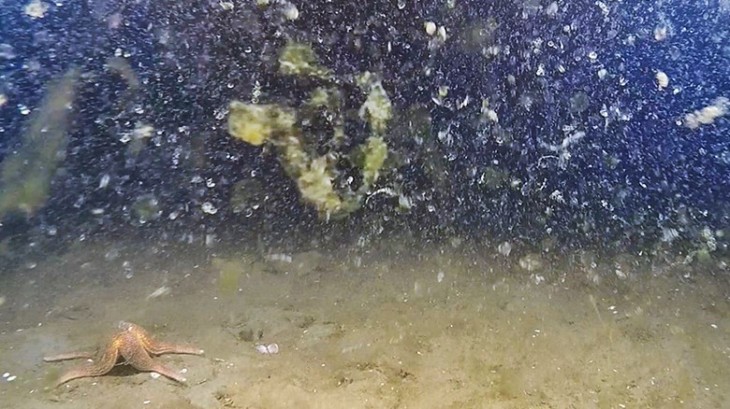
Particles known as “marine snow” trickle to the seabed. (Photo: Andreas Neumann / HZG)
It’s snowing in the oceans - every day, incessantly. Billions of fine particles and clumps are constantly trickling down toward the seafloor. Deep sea researchers, who have illuminated the dark ocean from their submarines with powerful lights, have been familiar with this phenomenon for decades. When they turn on the beams, the fine particles light up.
Although this underwater snow flurry has been known for such a long time, people still know little about it. It is clear that this “marine snow” is a biological waste product - mainly from dead algae, bits of faecal matter from crabs and other residue from many organisms that live and die near the sea surface. Scientists have been attempting to study this snowfall more precisely for a long time, but sampling these fragile particles is exceptionally difficult.
“The marine snow very likely plays a greater role in the seas than previously thought,” says Dr Klas Ove Möller, biological oceanographer at the Helmholtz-Zentrum Geesthacht’s (HZG’s) Institute of Coastal Research, “not only as food for marine animals, but also in the global carbon cycle.”
A working group for marine snow
Dr Klas Ove Möller founded the “Marine Particles and Plankton” working group in the fall of 2019 at the HZG, with which he intends to research more comprehensively in the coming years how vital the fine particle rain is for life in the sea as well as for the global climate.
Climate researchers across the globe have long been trying to determine to what extent the oceans absorb the greenhouse gas carbon dioxide. Carbon dioxide dissolves in seawater. The ocean can thus absorb a large quantity of the climate gas released by humans. It is, however, vital that the carbon dioxide disappears into the depths of the ocean so that it is removed from the atmosphere for many hundreds of years. Marine snow contributes in this regard: like plants on land, microalgae in the ocean - the phytoplankton - also absorb carbon dioxide. When they die, they sink in algal clumps toward the seabed.
“The crucial question is how much of the marine snow actually winds up on the seafloor,” says Dr Möller. “Because while it sinks, a portion of the dead biomass is eaten up again,” - mainly by zooplankton, small crabs, fish larvae or even small jellyfish. The problem is that hardly any researcher has ever examined the sumptuous marine snow feast in order to even estimate how much of the organic waste is being consumed.
Unsuitable measurement methods
There is a simple reason for this: there has so far been no technical options to observe what happens with marine snow. Zooplankton is traditionally fished from the sea using fine nets or pumps. The small animals are identified and counted under the microscope. From the water samples, the total amount of plankton in the water is then extrapolated.
These methods, however, are imprecise. “Small jellyfish, for example, are usually crushed and can hardly be counted, or copepod appendages usually break off during traditional sampling, making it difficult to determine the species,” says Dr Möller. “And whether the animals actually consumed marine snow or other food cannot be determined at all.”
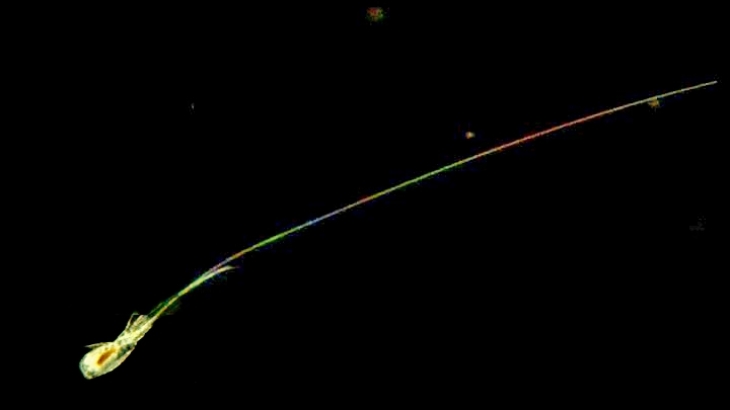
The copepod Microsetella with a long appendage that remained undiscovered for a long time due to traditional sampling methods. (Photo: Klas Ove Möller / HZG)
Zooplankton in a flash of light
It is for this reason that researchers like Dr Klas Ove Möller have been heading down a different route for some time. They use high-resolution underwater cameras to take photos of the marine snow. “We can use the cameras to precisely analyse individual particles and measure their size this way,” he says. Even the dead algae can sometimes be determined, and tiny bits of crab excrement can be made visible. Of course, the different types of zooplankton can also be seen bustling on the particles. “Through the photos we can determine their species as well as their quantity.”
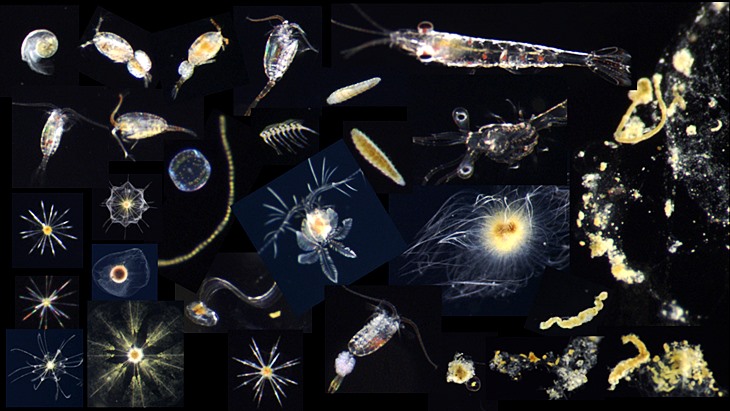
Zooplankton and marine snow photographed with an underwater camera (Photo: Klas Ove Möller / HZG)
Outdoor laboratory in the fjord
Together with scientists from Tromsø University in Norway, DTU in Denmark and MARUM in Bremen, Dr Möller precisely determined how much marine snow the zooplankton consumed in Balsfjord (northern Norway).
Balsfjord has very little current and is therefore an ideal region for investigation. The team was thus able to perfectly photograph the sinking particles with the camera system. The researchers ascertained that one species of zooplankton is particularly active here: a small copepod, the Microsetella norvegica, measuring only a half-millimetre long.
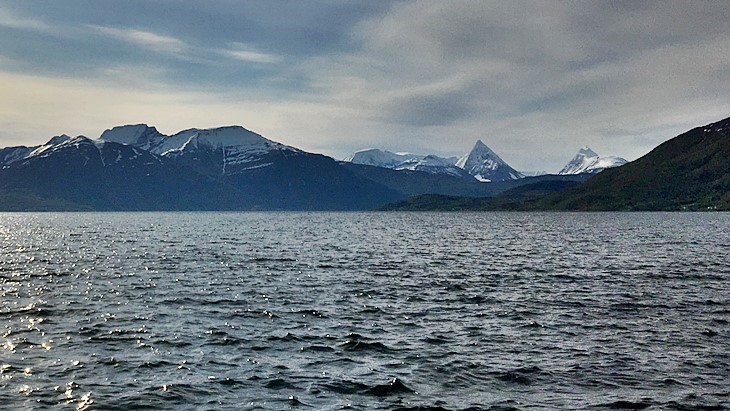
Balsfjord in Norway provides an ideal research area (Photo: Klas Ove Möller / HZG)
On the one hand, the researchers observed the crabs comfortably in the laboratory: they precisely measured how much the Microsetella eats during a given period of time. They subsequently took the underwater photos and recorded the physical properties of the seawater in the fjord. They could then extrapolate from the number of animals on the marine snow particles how much of that snow the animals consumed. While the particles sink, the copepods eat away approximately twenty per cent of the marine snow.
This allowed the German-Danish-Norwegian team to provide the first concrete figure worldwide on the feeding activity of free-living zooplankton on marine snow. This figure is substantial and crucial – especially for climate models in which the carbon balance of the marine snow has so far been taken into account only relatively imprecisely. “Both the marine snow itself as well as the zooplankton activity have so far been entirely underestimated because marine snow sampling up until now has been inexact,” says Dr Möller.
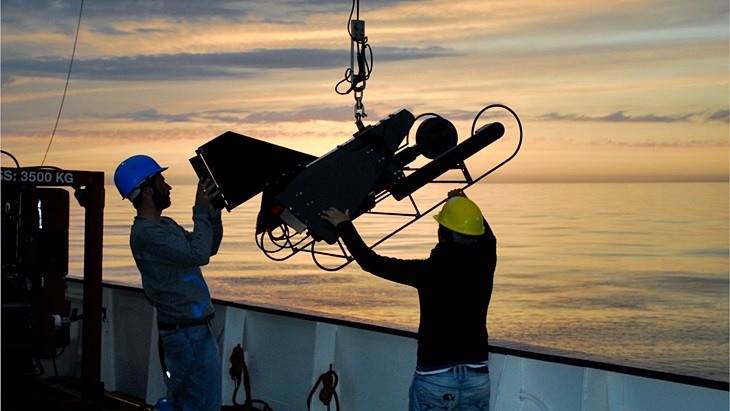
Deploying an autonomous video plankton recorder (DAVPR) (Photo: Klas Ove Möller / HZG)
International collaboration for consistent data
Möller intends to change this in cooperation with several research teams from other countries. The experts joined forces in the international working group TOMCAT, which specialises in observing marine snow using camera systems. One aim for the researchers is to standardise recording in the future so that different methods do not result in entirely different results.
One difficulty, for example, is to infer the size of marine snow particles and zooplankton in three-dimensional space – in a volume – from a two-dimensional photograph. The experts are working together on algorithms that will automatically evaluate the images in the future, therefore saving a great deal of time. For now the programs can already quite reliably distinguish copepods from particles and count them. Individual species, however, cannot yet be identified precisely enough.
The ultimate goal: real-time analysis and plankton TV
Dr Klas Ove Möller, together with his team as well as with partners from the Alfred Wegener and Thünen Institutes in Bremerhaven, tested a new camera system off of Helgoland in the past year. “We invested a great deal of time to remedy technical errors,” he says. “The camera lens was repeatedly overgrown with marine life, especially algae and barnacles. But we’re now ready to use the system in the long run.”
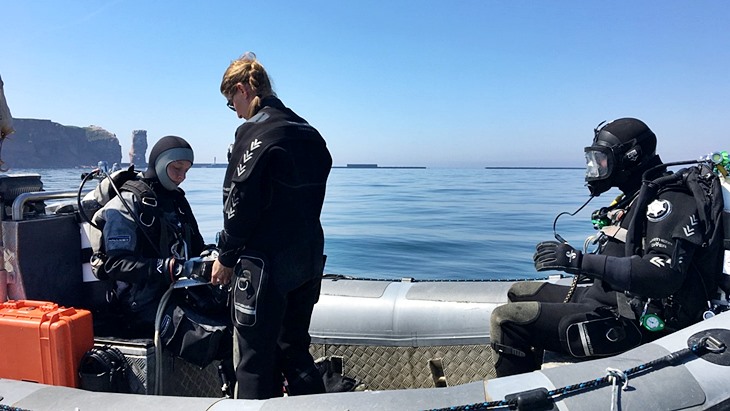
AWI diving groups off Helgoland (Photo: Klas Ove Möller / HZG)
A long-term test off Helgoland is to begin in May. The camera system is to remain in the water for a year or more and take photographs. In the long-term, Dr Möller intends to transmit marine snow and plankton data live to the laboratory so that it can be automatically analysed in real time. “I envision plankton and particle TV that can be installed in this form in the future in various marine regions or on research cruises while at the same time anyone at home can discover this fabulous underwater world live on the Internet.”
Understanding the influence of marine physics
With his new working group, Dr Möller also wants clarify how heavily the ocean currents influence the quantity or distribution of marine snow. It could be the currents that carry the particles from the coastal waters out to sea, or it could even be ocean eddies, which occur throughout the oceans and, like large kitchen blenders working in slow motion, stir the water column. As a biological oceanographer, Dr Möller is also interested in marine snow as a marine habitat. “We barely know anything about the living communities on the particles, the composition of the species – this is a realm that is still completely unexplored and for that reason particularly exciting.“
Marine snow transports microplastics
Marine snow could also play a considerable role in the topic of microplastics. Researchers have been asking themselves for some time why microplastic particles sink so far down though many of them are low in density and float in the water. Because microplastics have sometimes been observed entangled in marine snow, it is assumed that this is how they wind up on the seabed. To what extent these microplastics are transported can only be estimated when the quantity of marine snow is better known. There is no doubt that many exciting questions await Klas Ove Möller in the coming years.
(Text: Tim Schröder, Science Journalist / English Translation: Anupa Srinivasan)

